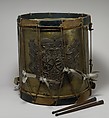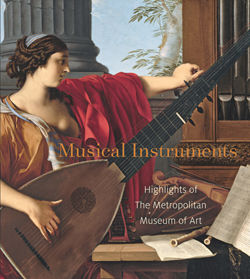Side Drum
Not on view
This side drum bears a magnificent royal cartouche with the cipher of Frederick Augustus II. Known by his nickname, "Augustus the Strong," he ruled as elector of Saxony (1694–1733) and king of Poland (1697–1704, 1709–33). The cartouche consists of many royal and military symbols, including a large crown, shields, swords, banners, and drums.
This brass shell drum was certainly a military instrument that would have been used to signal troops in the field and to provide cadences for a marching army. The drum would have been worn on a sling to a player's side, and played with two large sticks. Across the bottom head are two cords—consisting of a single piece of twisted gut—that rattle against the head when the drum is played, giving the drum its characteristic "buzzy" sound. A pair of eighteenth century drumsticks survive with this side drum.
Technical description: Brass (or copper alloy) shell, soldered seam. Shell decorated with a large metal cartouche with royal and military symbols including a crown, swords, banners, shields, and the initials of Frederick August 1, "The Strong," Elector of Saxony and King of Poland (1694-1733). Rope tension, originally with ten leather tugs (eight remain). Wooden counter hoops painted with diagonal stripes alternating blue and gold (city colors of Dresden) with a thin line of white between. Ten drilled holes in each counter hoop through which the rope passes. Brass, j-hook snare adjuster mounted vertically, parallel to the shell. Calfskin heads. Two gut snares held in place opposite the strainer by the counter hoop. (Jayson Kerr Dobney 2003)
Due to rights restrictions, this image cannot be enlarged, viewed at full screen, or downloaded.


